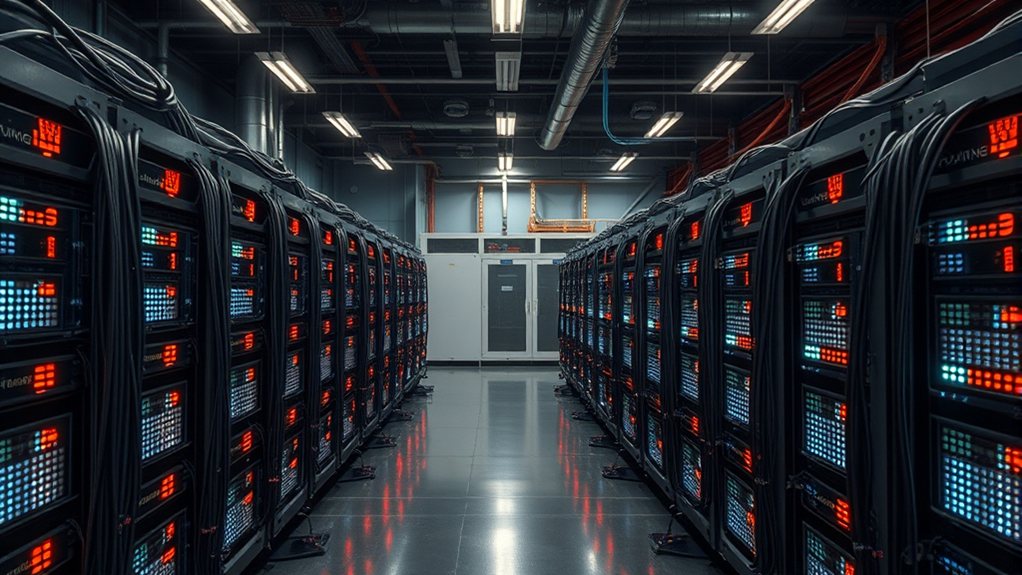A cryptocurrency farm is a large facility where specialized computers work non-stop to create new digital currencies and validate blockchain transactions. These operations use powerful ASIC miners or GPUs that require substantial electricity and cooling systems to prevent overheating. Farms typically occupy warehouses with robust electrical infrastructure and security measures. They're often located in regions with cheap power to maximize profits. The environmental impact and regulations of these energy-intensive operations vary worldwide.

Hubs of digital mining activity, cryptocurrency farms are large-scale operations where hundreds or thousands of specialized computers work non-stop to create new digital money. These facilities serve multiple purposes beyond just generating cryptocurrency tokens. They help validate transactions on blockchain networks and contribute to the security and decentralization that make cryptocurrencies function properly.
These farms use specific hardware designed for mining. Most operations rely on ASIC miners, which are computers built for one task only: mining cryptocurrency. As Bitcoin's popularity grew, miners evolved from using regular CPUs to more efficient ASIC technology around 2013. Some farms use GPUs (graphics cards) instead, especially for coins like Ethereum. Every farm needs powerful electricity supplies and cooling systems to keep equipment from overheating. Network equipment guarantees all machines stay connected to the internet.
The specialized nature of mining equipment requires dedicated power and cooling infrastructure to maintain operational efficiency.
Setting up a cryptocurrency farm requires substantial infrastructure. Owners typically use large warehouses or industrial buildings to house all the equipment. The electrical systems must handle massive power loads, often requiring special industrial connections. Fast and reliable internet is essential, as miners must stay connected to cryptocurrency networks at all times. Climate control systems prevent equipment damage, while security measures protect the valuable hardware. These operations utilize central cooling systems to prevent the overheating of mining computers, ensuring optimal performance and longevity of equipment.
The energy consumption of cryptocurrency farms is enormous. Large operations can use as much electricity as small towns. Due to these high power needs, many farms locate in places with cheap electricity. There's growing interest in using renewable energy sources like solar, wind, or hydroelectric power to reduce costs and environmental impacts. The mining process involves solving complex algorithms that secure the cryptocurrency network while preventing fraudulent transactions from being recorded on the blockchain.
From a business perspective, cryptocurrency farms require significant money to start. The initial investment covers building space, mining machines, electrical infrastructure, and cooling systems. Daily expenses include electricity bills and maintenance costs. A farm's profitability depends mainly on cryptocurrency prices and competition levels. Larger operations often benefit from economies of scale, making them more efficient.
Environmental concerns surround cryptocurrency mining. Critics point to the carbon footprint created by electricity-hungry farms powered by fossil fuels. Some operations are addressing these worries by switching to renewable energy. There's also the issue of e-waste when old mining equipment becomes obsolete and needs disposal.
Regulations for cryptocurrency farms vary widely worldwide. Some countries welcome mining operations, while others have banned them completely. Farm operators must navigate taxes on their earnings and may face increasing scrutiny about their energy use. As cryptocurrency continues to grow, governments are developing more specific rules for these digital mining operations.
Frequently Asked Questions
How Much Electricity Does a Typical Cryptocurrency Farm Consume?
Cryptocurrency farms consume varying amounts of electricity based on their size.
Mid-size operations typically use 1-5 megawatts, equivalent to powering 1,000-5,000 homes. Large farms can draw 10-20 megawatts, with some exceeding 100 megawatts.
Small home setups use just 1-5 kilowatts. Energy usage depends on hardware efficiency, cooling needs, and local climate.
Electricity costs represent 60-80% of a farm's operating expenses.
What Are the Noise Levels Like in a Cryptocurrency Mining Operation?
Cryptocurrency mining operations are extremely noisy.
Single mining machines generate 70-90 decibels, while large farms can exceed 100 decibels—as loud as a jet engine.
This noise comes mainly from cooling fans working continuously to prevent overheating.
The constant noise can cause serious health problems for workers and nearby residents, including hearing damage, sleep disturbances, and increased stress levels.
Are Cryptocurrency Farms Legal in All Countries?
Cryptocurrency farms aren't legal in all countries. The legal status varies widely across the globe.
Some nations like the United States, Canada, and Switzerland have embraced crypto mining with regulations. Others, including China, Algeria, and Nepal, have banned these operations entirely.
Many countries exist in a regulatory "grey area" with evolving rules. Regulations typically address energy consumption, taxation, financial oversight, and anti-money laundering concerns.
How Quickly Do Mining Rigs Become Obsolete?
Mining rigs typically become obsolete within 2-3 years. New hardware releases every 12-18 months offer 20-30% better performance.
Bitcoin halving events, which cut mining rewards in half, accelerate this obsolescence. ASIC miners generally have 3-5 years of profitable use, while GPUs last longer due to their versatility.
Factors affecting a rig's lifespan include electricity costs, market prices, and maintenance quality. Hardware failure rates increase considerably after 2-3 years of operation.
What Happens to Mining Hardware After It's No Longer Profitable?
Obsolete mining hardware often faces several fates.
Some miners recycle devices through specialized programs that recover valuable metals. Others repurpose old rigs as space heaters in cold climates or sell components on secondary markets.
Many units are repurposed for mining smaller cryptocurrencies that don't require cutting-edge equipment.
Unfortunately, a significant portion becomes e-waste, contributing to the growing problem of electronic waste worldwide.










